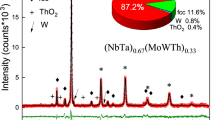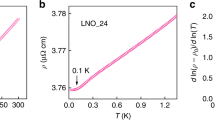Abstract
WE have investigated the magnetic behaviour of lanthanum below 10° K. The metal was kindly lent to us by Prof. F. M. Jaeger of Groningen; the analysis was given as lanthanum 98 per cent, iron 1 per cent and traces of carbon, silicon, aluminium and magnesium. Two lumps of irregular shape were tested by methods described previously1,2. Strong diamagnetic susceptibility, which could be destroyed by a magnetic field, showed that the specimens became supracoiiductive. After supraconductivity had been destroyed by a magnetic field, the magnetic flux threading the specimens froze in when the field was lowered again. The formation of such a supra-conductive sponge was to be expected in a specimen containing 2 per cent of impurities3.
This is a preview of subscription content, access via your institution
Access options
Subscribe to this journal
Receive 51 print issues and online access
$199.00 per year
only $3.90 per issue
Buy this article
- Purchase on Springer Link
- Instant access to full article PDF
Prices may be subject to local taxes which are calculated during checkout
Similar content being viewed by others
References
Mendelssohn, k., and Moore, J. R., Phil. Mag., (21), 7, 532 (1936).
Mendelssohn, K., Proc. Roy. Soc., A, 155, 558 (1936).
Keeley, T. C., Mendelssohn, K., Proc. Roy. Soc., A, 154, 378 (1936).
Mendelssohn, K., and Babbitt, J. D., Proc. Roy. Soc., A, 151, 316 (1935).
Author information
Authors and Affiliations
Rights and permissions
About this article
Cite this article
MENDELSSOHN, K., DAUNT, J. Supraconductivity of Lanthanum. Nature 139, 473–474 (1937). https://doi.org/10.1038/139473c0
Issue Date:
DOI: https://doi.org/10.1038/139473c0
Comments
By submitting a comment you agree to abide by our Terms and Community Guidelines. If you find something abusive or that does not comply with our terms or guidelines please flag it as inappropriate.



